<< Our Photo Pages >> Knossos - Ancient Palace in Greece in Crete
Submitted by Thorgrim on Friday, 12 November 2004 Page Views: 15708
Neolithic and Bronze AgeSite Name: Knossos Alternative Name: ΚνοσσοςCountry: Greece Region: Crete Type: Ancient Palace
Nearest Town: Iraklion Nearest Village: Knossos
Latitude: 35.297953N Longitude: 25.163373E
Condition:
| 5 | Perfect |
| 4 | Almost Perfect |
| 3 | Reasonable but with some damage |
| 2 | Ruined but still recognisable as an ancient site |
| 1 | Pretty much destroyed, possibly visible as crop marks |
| 0 | No data. |
| -1 | Completely destroyed |
| 5 | Superb |
| 4 | Good |
| 3 | Ordinary |
| 2 | Not Good |
| 1 | Awful |
| 0 | No data. |
| 5 | Can be driven to, probably with disabled access |
| 4 | Short walk on a footpath |
| 3 | Requiring a bit more of a walk |
| 2 | A long walk |
| 1 | In the middle of nowhere, a nightmare to find |
| 0 | No data. |
| 5 | co-ordinates taken by GPS or official recorded co-ordinates |
| 4 | co-ordinates scaled from a detailed map |
| 3 | co-ordinates scaled from a bad map |
| 2 | co-ordinates of the nearest village |
| 1 | co-ordinates of the nearest town |
| 0 | no data |
Internal Links:
External Links:
I have visited· I would like to visit
SolarMegalith visited on 24th Apr 2018 - their rating: Cond: 3 Amb: 2 Access: 5
Jansold visited on 8th Aug 2012 - their rating: Cond: 3 Amb: 3 Access: 5
43559959 visited on 15th Jun 1977 - their rating: Cond: 5 Amb: 5 Access: 5 New visit in april 2013.
MegalithJunkie visited - their rating: Cond: 4 Amb: 5 Access: 3
Klingon visited - their rating: Cond: 5 Amb: 4 Access: 5
Kuba visited - their rating: Cond: 4 Amb: 4 Access: 4
DrewParsons davidmorgan keniaar have visited here
Average ratings for this site from all visit loggers: Condition: 4 Ambience: 3.83 Access: 4.5
Theseus and the Minotaur - a wonderful tale of heroes, gods and monsters in a fabulous palace built by Daedalus and ruled by King Minos. Doomed Athenian youths sent in annual tribute to Crete as sacrificial victims. There to be hunted by the bull headed Minotaur in the underground maze of the labyrinth from which only Theseus could escape by means of the unwinding thread given to him by Ariadne, the King's daughter. Just a story until the palace, the labyrinth and the bulls were found in 1900 by Sir Arthur Evans at Knossos.
The earliest occupation of Crete dates to the Neolithic from about 7000 BC. The transition to the Bronze Age occurred around 3500 BC and there was much contact with Egypt. The palaces, of which Knossos is only one, began around 1900 BC and lasted until about 1500 BC. They were incredibly rich in gold, jewels and the fine arts and crafts. The people were well fed, prosperous and highly sophisticated - yet there were no fortifications of any kind - no defences other than the sea. Was this a golden age of peace and prosperity?
The Minoan landscape was densely populated and dominated by country villas, while urbanisation surrounded the enormous palaces of Knossos, Phaistos, Mallia and Zakros. These palaces were centres for craftsmen working in stone, ivory and gold. The gypsum throne of King Minos is still in place and is the oldest throne in Europe. There are superb wall paintings of leaping dolphins and flying fish in a style similar to that which we call Art Nouveau today. Pottery with such bold colourful designs that they would not look out of place in a modern designer gallery. Vast jars of grain and oil to feed the multitude. Young men and women athletes danced with gigantic bulls and somersaulted over their backs by catching the horns of the charging bull. Beautiful women with oiled hair, wearing flounced skirts with tight bodices that left their breasts bare. The cult of the snake and that of the bull. Women seem to have enjoyed high status and the many wall paintings show them chatting and enjoying court life. There are exquisite seals and statuettes that show the Snake Goddess and her attendants in dominant attitudes while men salute them.
So what went wrong? The relationship of Crete to Egypt and to Mycenaean Greece is unclear. Until quite recently it was believed that the end of Minoan Crete was caused by the devastating eruption of a huge volcano in 1500 BC on the island of Thera (Santorini) to the north of Crete. Thera exploded. The eruption was massive and blew half the island away. A great tidal wave must have devastated the northern coastline of Crete and volcanic ash would have blanketed the land and destroyed crops. Then earthquakes struck Crete and palaces were destroyed. But the Minoan civilisation survived although only Knossos was rebuilt. Now life was very different for the Minoans. The old gods were blamed for the disaster - the statues of the Snake Goddess were deliberately smashed and buried beneath the palace floor at Knossos. Oil jars were overturned to feed the blaze when buildings were deliberately set on fire. Male gods replaced female gods, but these too were destroyed and their shrines burnt, perhaps by the followers of the dispossessed Goddess. Strange sea creatures like the octopus came to dominate pottery design and then came total collapse. People fled to the mountains and eked out a wretched existence. They appear to have been terrified to descend to the lowlands and to the seashore. Did the collapse of Crete lead to invasion and dominance by the warriors of Mycenae? Whatever the cause, the most remarkable early civilisation of the ancient world came to an end. Its truly incredible art and architecture was buried and became a fairy tale myth until one day that myth became reality.
You may be viewing yesterday's version of this page. To see the most up to date information please register for a free account.










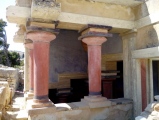





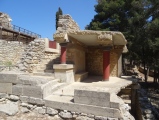


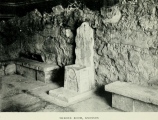

These are just the first 25 photos of Knossos. If you log in with a free user account you will be able to see our entire collection.
Do not use the above information on other web sites or publications without permission of the contributor.
Click here to see more info for this site
Nearby sites
Click here to view sites on an interactive map of the areaKey: Red: member's photo, Blue: 3rd party photo, Yellow: other image, Green: no photo - please go there and take one, Grey: site destroyed
Download sites to:
KML (Google Earth)
GPX (GPS waypoints)
CSV (Garmin/Navman)
CSV (Excel)
To unlock full downloads you need to sign up as a Contributory Member. Otherwise downloads are limited to 50 sites.
Turn off the page maps and other distractions
Nearby sites listing. In the following links * = Image available
5.0km SSW 200° Anemospilia* Ancient Temple
5.2km NNW 333° Heraklion Museum of Archaeology* Museum
5.2km S 180° Archanes Theatre* Modern Stone Circle etc
5.4km NE 45° Temple of Zeus Thenatas* Ancient Temple
5.9km S 184° Phourni* Chambered Tomb
6.7km SSW 195° Juktas* Ancient Temple
9.9km S 187° Vathypetro* Ancient Village or Settlement
12.2km E 86° Skotino Cave* Cave or Rock Shelter
13.0km W 270° Tylisos* Ancient Village or Settlement
18.6km W 269° Sklavokampos* Ancient Village or Settlement
20.6km E 83° Hersonissos* Ancient Village or Settlement
25.7km WSW 258° Zominthos* Ancient Village or Settlement
28.7km W 272° Panagia (Axos)* Ancient Village or Settlement
28.9km W 272° Tihio (Axos)* Rock Cut Tomb
29.0km W 272° Ancient Axos* Ancient Village or Settlement
29.3km ESE 108° Karfi* Ancient Village or Settlement
29.6km W 273° Dimitra Sanctuary* Rock Cut Tomb
29.7km ESE 120° Andros Cave* Cave or Rock Shelter
29.9km E 91° Malia* Ancient Palace
29.9km E 90° Mallia Ossuaries* Natural Stone / Erratic / Other Natural Feature
30.0km E 90° Chrysolakkos Cemetery* Natural Stone / Erratic / Other Natural Feature
32.0km WSW 252° Ideon Andron* Cave or Rock Shelter
32.7km SW 217° Gortys* Ancient Village or Settlement
33.2km E 88° Sissi-Kephala Ancient Village or Settlement
35.1km SSE 146° Kephala Ancient Village or Settlement
View more nearby sites and additional images

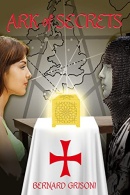

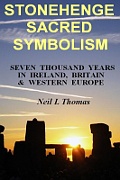


 We would like to know more about this location. Please feel free to add a brief description and any relevant information in your own language.
We would like to know more about this location. Please feel free to add a brief description and any relevant information in your own language. Wir möchten mehr über diese Stätte erfahren. Bitte zögern Sie nicht, eine kurze Beschreibung und relevante Informationen in Deutsch hinzuzufügen.
Wir möchten mehr über diese Stätte erfahren. Bitte zögern Sie nicht, eine kurze Beschreibung und relevante Informationen in Deutsch hinzuzufügen. Nous aimerions en savoir encore un peu sur les lieux. S'il vous plaît n'hesitez pas à ajouter une courte description et tous les renseignements pertinents dans votre propre langue.
Nous aimerions en savoir encore un peu sur les lieux. S'il vous plaît n'hesitez pas à ajouter une courte description et tous les renseignements pertinents dans votre propre langue. Quisieramos informarnos un poco más de las lugares. No dude en añadir una breve descripción y otros datos relevantes en su propio idioma.
Quisieramos informarnos un poco más de las lugares. No dude en añadir una breve descripción y otros datos relevantes en su propio idioma.